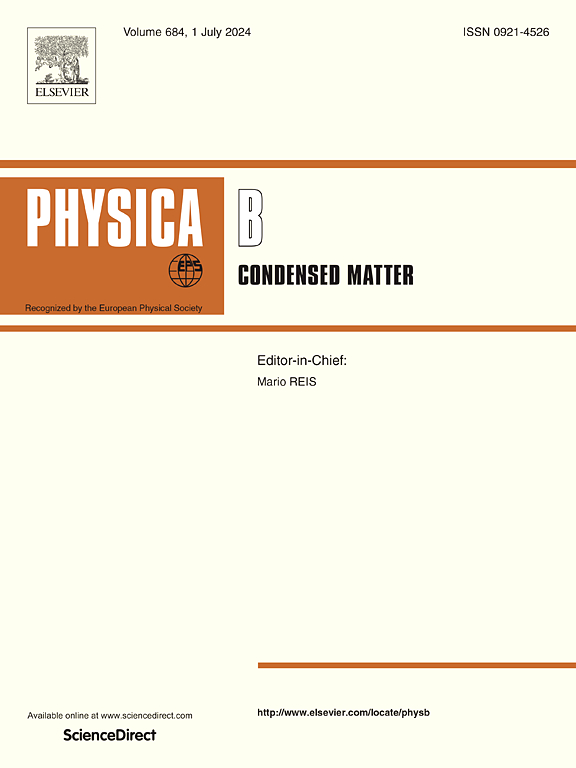氮掺杂BiVO4/CrFe2O4@CNTs异质结增强光催化降解农药的制备
IF 2.8
3区 物理与天体物理
Q2 PHYSICS, CONDENSED MATTER
引用次数: 0
摘要
光催化技术作为一种绿色环保技术,因其高能效和可持续性而备受关注。然而,光生电子-空穴对的复合速度非常快,从而降低了量子效率。最近的进展表明,异质结基材料的制造可以解决这些限制。本文采用超声共沉淀法制备了氮掺杂BiVO4 (NBVO)、CrFe2O4 (CF)和碳纳米管基纳米复合材料(NBVO/CF@CNTs)。用不同的物理化学技术对制备的样品进行了表征。x射线衍射(XRD)分别证实了NBVO和CF的单斜晶和尖晶石晶体结构。扫描电镜(SEM)证实了碳纳米管与NBVO/CF纳米颗粒的缠结。光学分析表明,复合材料形成后带隙能量降低,极大地提高了NBVO/CF@CNTs的光催化效率。光致发光(PL)分析证实NBVO/CF@CNTs在所有制备的光催化剂中重组率最低。将合成的光催化剂用于毒死蜱(CP)和三唑磷(TA)的光降解。与NBVO、CF和NBVO/CF相比,NBVO/CF@CNTs的降解效率最高(88% CP和85% TA)。NBVO/CF@CNTs具有优异的光催化性能,主要归因于活性位点的增加、带隙能量的降低和光生物质的分离率的提高。NBVO/CF@CNTs是一种高效稳定的废水光催化剂。本文章由计算机程序翻译,如有差异,请以英文原文为准。
Fabrication of nitrogen-doped BiVO4/CrFe2O4@CNTs heterojunction for enhanced photocatalytic degradation of pesticides
Photocatalysis, a green technology for environmental protection, is gaining attention due to its energy efficiency and sustainability. However, the recombination of photogenerated electron-hole pairs is very fast, which decreases quantum efficiency. Recent advances suggest that the fabrication of heterojunction-based materials can address these limitations. In the present work, Nitrogen-doped BiVO4 (NBVO), CrFe2O4 (CF), and CNTs-based nanocomposite (NBVO/CF@CNTs) were fabricated via a simple co-precipitation and ultrasonication method. The fabricated samples were characterized using different physicochemical techniques. X-rays Diffraction (XRD) confirms the monoclinic and spinel crystal structure for NBVO and CF respectively. Scanning Electron Microscopy (SEM) confirms the entanglement of carbon nanotubes with nanoparticles of NBVO/CF. Optical analysis reveals the decrease in bandgap energy after composite formation which greatly enhances the photocatalytic efficiency of NBVO/CF@CNTs. The photoluminescence (PL) analysis confirmed that NBVO/CF@CNTs have lowest recombination rate among all prepared photocatalysts. The synthesized photocatalysts were employed in the photodegradation of chlorpyrifos (CP) and Triazophos (TA). The degradation efficiency of the NBVO/CF@CNTs was highest (88 % CP and 85 % TA) as compared to the NBVO, CF, and NBVO/CF. The excellent photocatalytic properties of NBVO/CF@CNTs were attributed to the increase in active sites, reduction in bandgap energy and enhanced separation rate of photogenerated species. The NBVO/CF@CNTs proved to be an efficient and stable photocatalyst for wastewater remediation.
求助全文
通过发布文献求助,成功后即可免费获取论文全文。
去求助
来源期刊

Physica B-condensed Matter
物理-物理:凝聚态物理
CiteScore
4.90
自引率
7.10%
发文量
703
审稿时长
44 days
期刊介绍:
Physica B: Condensed Matter comprises all condensed matter and material physics that involve theoretical, computational and experimental work.
Papers should contain further developments and a proper discussion on the physics of experimental or theoretical results in one of the following areas:
-Magnetism
-Materials physics
-Nanostructures and nanomaterials
-Optics and optical materials
-Quantum materials
-Semiconductors
-Strongly correlated systems
-Superconductivity
-Surfaces and interfaces
 求助内容:
求助内容: 应助结果提醒方式:
应助结果提醒方式:


